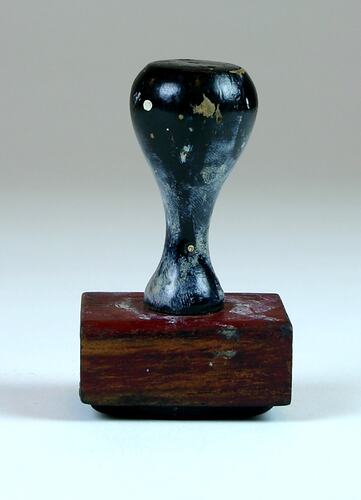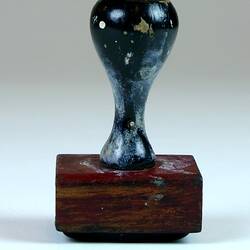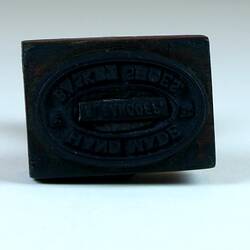Summary
This 1930s rubber stamp, complete with its black wooden handle and brown/red rectangular wooden block, illustrates the inscription HANDMADE/ S FANCOFF./ BASKET SHOES. This particular stamp bearing Stanio Fancoff's trademark was used on several of his sample shoe's sole bases to indicate these objects were crafted by Stanio Fancoff. This stamp is an icon of both Stanio's shoemaking craft and his business skills.
Stanio Ivanoff Fancoff was born in 1908 in Bojentsi, a small village in Bulgaria. At age 11, Stanio left home to learn the shoemaking trade. In 1929, he immigrated to Melbourne, settled in Fitzroy and began to work for the V.G. Zemancheff & Sons basket shoe factory in South Melbourne. In1936, he married Dorotea Georgi Touzou who had recently arrived in Australia. Around this time, Stanio set up his own shoemaking business from home, with Georgi, her cousin and sister weaving the shoes which he then assembled. Select shoe samples were then taken to Sydney and Tasmania for sale. In 1942, Georgi and Stanio moved to Broken Hill for Georgi's health; there daughter Nancy was born and Stanio set up a shoe shop/factory. In 1945, Georgi died and by 1950 Stanio and Nancy had moved to Adelaide where he again opened a shoemaking business and shop. He passed away in 1978, having been in the shoemaking business for 59 years. This collection documents his migration and working life experiences.
Physical Description
Oval shaped rubber stamp divided within two rings. Within the outer ring upper the inscription 'HANDMADE' appears, whereas the lower portion states 'BASKET SHOES'. The interior ring exhibits the crafter's name 'S FANCOFF.'. The rubber stamp is placed onto a supporting wood block measuring 42mm x 30mm x 17mm which appears painted within a brown/red hue. A black painted wooden handle with a thumbrest upon top has been added to the wooden block for ease of stamp use. However, both the handle and the wooden block indicate minor loses of paint application. Furthermore the handle exhibits signs of white or cream smudges possible transferred during its use.
Significance
This collection is significant in documenting a small migrant business as well as the fashion of a particular period. It is well provenanced and charts the application of trade skills in a new country. It also illustrates the stages of hand shoe manufacture from the 1930s, demonstrating the enduring nature of the tools and patterns that were used.
More Information
-
Collecting Areas
-
Acquisition Information
Donation from Nancy Vasileff, 21 Mar 2007
-
Past Owner or User
-
Inscriptions
HANDMADE / S FANCOFF. / BASKET SHOES
-
Classification
-
Category
-
Discipline
-
Type of item
-
Overall Dimensions
42 mm (Width), 30 mm (Depth), 72 mm (Height)
-
References
R.A. Salaman, 'Dictionary of Leather-working Tools c.1700-1950 and Tools of Allied Trades,' London: George Allen and Unwin (Publishers) Ltd, 1986 [Section 2: Boot and Shoe Maker pp18-185]. John Peacock. 'Shoes, The Complete Sourcebook,' London:Thames & Hudson Ltd, 2005. NAA holds file (online) on Vasil George Zemancheff, Fancoff's employer
-
Keywords
Boot & Shoemaking, Bulgarian Communities, Bulgarian Immigration, Immigration, Small Businesses, Tools



